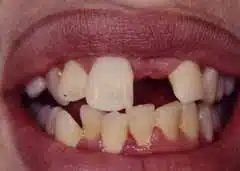A dental implant can be a long-lasting option for the replacement of a missing single tooth. A missing tooth can negatively affect your dental health, your appearance, and your self-esteem. The teeth work together when you chew, producing micro-movements that stimulate your jawbone and gums, which helps to keep them healthy. A missing tooth inhibits this natural process, causing bone and gums to erode.
When a tooth is missing, the opposing tooth can super-erupt. Bone loss around the tooth can eventually lead to the loss of the opposing tooth. In addition, there is nothing to maintain the space. Shifting can occur, which will alter your bite (occlusion). There are three common options for the replacement of a single missing tooth. They include a removable prosthesis, a bridge supported by natural teeth, and an implant-supported crown.
OTHER ALTERNATIVES:
A removable prosthesis or “flipper”:
Most patients are not satisfied with this alternative because of the bulk metal and acrylic and the unsightly clasps necessary to stabilize the prosthesis.
A bridge supported by natural teeth:
For this option, the adjacent teeth are prepared to support the bridge. This can shorten the lifespan of healthy adjoining teeth. In addition, if there is a problem with one of the supporting bridge’s teeth, the entire bridge will need to be replaced.
Treatment Protocol Using Teeth In A Day®: Steps for single tooth implant placement.
 |
The missing tooth root is replaced with a dental implant. This dental implant will bond with surrounding bone, providing a firm foundation for the crown. |
 |
Using the Teeth In A Day® Protocol, a temporary acrylic tooth can be placed at the time of dental implant placement for immediate esthetics. |
 |
Placement of the final tooth – Our professional techniques ensure optimal size, shape, color, and fit. These single restorations blend beautifully with your facial characteristics and natural teeth. |
A single-tooth implant-supported crown:
Dental implants are small titanium screws that replace and function like natural tooth roots. Implants are placed gently during a short surgical procedure, then a fixed crown is mounted on it.
This non-removable solution looks and feels natural and is easier to clean. You can floss between the implant-supported single tooth and the adjoining teeth.
Unlike the alternatives, dental implants do not endanger the adjoining teeth because they are not required to provide support. With good dental maintenance, your single-tooth implant can have long-term success. Dr. Slauch states, “The use of a dental implant to for a single tooth is considered the standard of care for the replacement of a missing tooth because of the benefits of being fixed (non-removable), feeling like a natural tooth and the ability to floss and clean it like a regular tooth.”
- Stable
- Attractive
- Long-Lasting
- Natural
- Healthy
Before and After Photos of a Single Tooth Restoration
| Male Patient Photos |
  |
| Female Patient Photos |
  |
MORE INFORMATION ABOUT THE SINGLE TOOTH IMPLANT:
LINKS:
Eight Reasons to Replace a Missing Tooth
